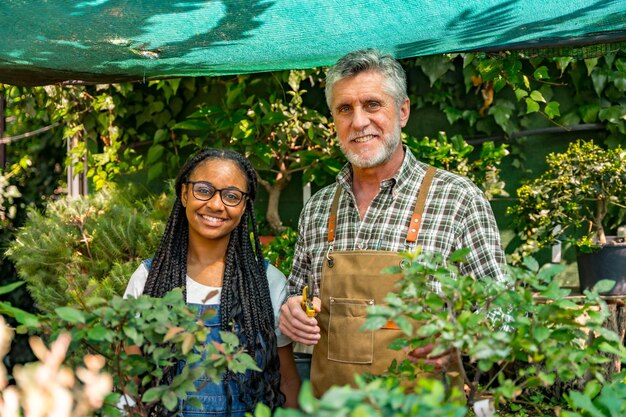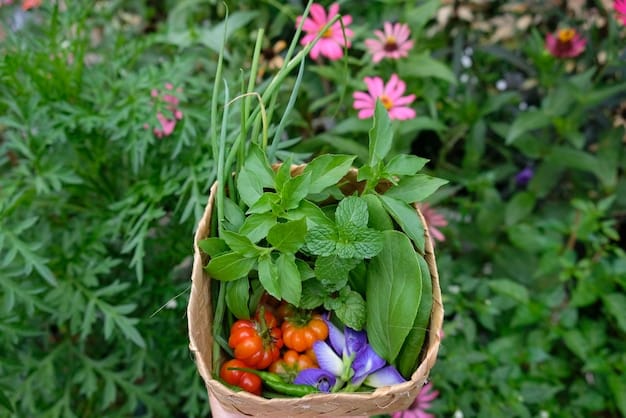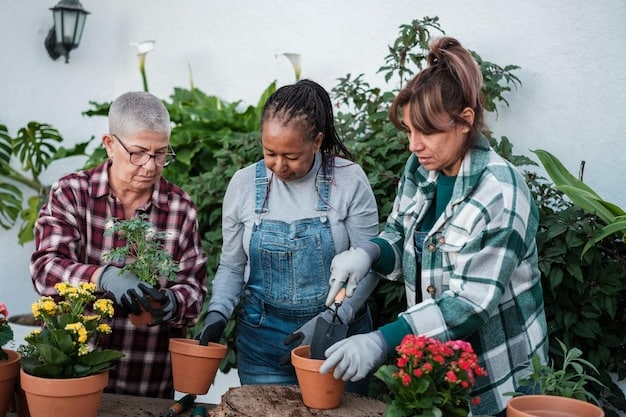Community Gardens: Cultivating Food, Community, and a Sustainable Future

Community gardens are shared spaces where people grow food, build relationships, and promote sustainability, offering numerous benefits to individuals and the environment.
Community gardens: growing food, building relationships, and fostering sustainability—these green havens offer more than just fresh produce. They cultivate connections, enhance well-being, and promote eco-conscious practices in neighborhoods across the US. Let’s dig deeper into the transformative power of shared green spaces.
Unearthing the Roots of Community Gardens
Community gardens have a rich history, evolving from wartime “victory gardens” to modern-day hubs of urban agriculture. Understanding their origins sheds light on their enduring appeal and importance in contemporary society.
The Historical Tapestry of Community Gardens
The concept of community gardens isn’t new. Throughout history, people have come together to cultivate shared land for sustenance and social connection.
Modern Community Gardens: A Blooming Renaissance
Today’s community gardens are a diverse tapestry of initiatives. They range from small, neighborhood plots to large-scale urban farms, each catering to the specific needs and aspirations of its community.
- 🌱 **Urban Renewal:** Community gardens revitalize blighted urban spaces, transforming them into productive green areas.
- 🤝 **Social Cohesion:** They create opportunities for neighbors to connect, share knowledge, and build lasting friendships.
- 🍎 **Access to Fresh Food:** Gardens provide access to affordable, healthy produce, especially in food deserts where fresh options are limited.
In essence, the evolution of community gardens reflects changing societal needs and priorities. They are a testament to the power of collective action and the enduring human desire to connect with nature and each other.

In conclusion, community gardens have deep roots in history and continue to evolve, meeting contemporary needs for food access, social connections, and environmental sustainability.
Cultivating a Bounty: The Benefits of Growing Your Own Food
One of the most tangible benefits of community gardens is the opportunity to grow your own food. This not only provides access to fresh, healthy produce but also fosters a deeper understanding of the food system.
Nourishing Your Body and Soul
Growing your own food empowers you to make healthier choices and connect with the natural world.
- 🍅 **Fresh, Local Produce:** Enjoy the superior taste and nutritional value of locally grown fruits and vegetables.
- 💪 **Physical Activity:** Gardening provides gentle exercise, improving strength, flexibility, and overall fitness.
- 🧠 **Mental Well-being:** The act of gardening can reduce stress, improve mood, and promote a sense of accomplishment.
Beyond the individual benefits, growing your own food in a community garden fosters a greater appreciation for the environment and the interconnectedness of all living things.
In summary, nurturing a garden plot leads to both personal health gains and heightened awareness of our place in the ecosystem.
Building Bridges: The Social Fabric of Community Gardens
Community gardens are more than just plots of land; they are vibrant social spaces where people from diverse backgrounds come together to share, learn, and connect. This social fabric is a vital component of the community garden experience.
Fostering Collaboration and Friendship
Working alongside others in a community garden creates opportunities for collaboration, knowledge sharing, and the formation of lasting friendships.
Bridging Divides: Diversity and Inclusion
Community gardens often bring together people from different cultures, age groups, and socioeconomic backgrounds. This diversity enriches the garden and creates opportunities for cross-cultural understanding.

The social benefits of community gardens extend beyond the garden gates. They create a sense of belonging and civic engagement, strengthening the overall fabric of the community.
In conclusion, community gardens are powerful platforms for social interaction, bridging divides and fostering a stronger sense of community.
Sowing Sustainability: Environmental Impact of Community Gardens
Community gardens play a vital role in promoting environmental sustainability. From reducing food miles to conserving water, these green spaces offer a range of ecological benefits.
Minimizing the Carbon Footprint
Growing food locally reduces the need for long-distance transportation, which translates to fewer greenhouse gas emissions.
Conserving Resources and Promoting Biodiversity
Sustainable gardening practices, such as composting and rainwater harvesting, help conserve valuable resources. Community gardens also provide habitat for pollinators and other beneficial insects, promoting biodiversity.
- ♻️ **Composting:** Recycling food scraps and yard waste reduces landfill waste and creates nutrient-rich soil.
- 💧 **Water Conservation:** Implementing efficient irrigation techniques minimizes water usage.
- 🐝 **Pollinator Support:** Planting flowers that attract bees and butterflies helps support these essential pollinators.
By embracing sustainable practices, community gardens serve as models for environmentally responsible living and contribute to a healthier planet.
In summary, adopting eco-friendly habits helps the environment and creates a more sustainable food system.
Overcoming Challenges: Ensuring the Success of Community Gardens
While community gardens offer numerous benefits, they also face challenges such as funding, land access, and volunteer management. Addressing these challenges is essential for ensuring their long-term sustainability.
Securing Funding and Resources
Community gardens often rely on grants, donations, and volunteer labor to operate. Diversifying funding sources and building strong community partnerships are crucial for financial stability.
Navigating Land Access and Ownership
Securing long-term access to land can be a major hurdle. Working with local governments, land trusts, and private landowners can help ensure the garden’s future.
By addressing these challenges proactively and collaboratively, community gardens can thrive and continue to serve as vital resources for their communities.
In conclusion, tackling challenges like funding and land access ensures they serve communities well for years to come.
Getting Involved: Planting the Seeds of Change
Whether you’re a seasoned gardener or a complete novice, there are many ways to get involved in community gardens. Your participation can make a real difference in your own life and the life of your community.
Finding and Joining a Local Garden
Start by researching community gardens in your area. Visit local gardens, talk to gardeners, and explore opportunities to volunteer or rent a plot.
Sharing Your Skills and Knowledge
Contribute your unique skills and knowledge to the garden. Whether you’re a skilled carpenter, a composting expert, or a social media whiz, your talents can help the garden thrive.
Community gardens are living laboratories for learning and growth. By participating, you’ll not only gain valuable skills but also contribute to a more vibrant and sustainable community.
| Key Point | Brief Description |
|---|---|
| 🌱 Growing Food | Access to fresh, healthy, and locally sourced produce for community members. |
| 🤝 Building Relationships | Creating social connections and fostering friendships among diverse individuals. |
| 🌍 Sustainability | Promoting eco-friendly practices like composting and water conservation. |
| 💪 Community Impact | Revitalizing urban spaces and increasing civic engagement. |
Frequently Asked Questions
▼
A community garden is a shared space where people grow fruits, vegetables, and flowers. It fosters community interaction, provides access to fresh produce, and promotes environmental awareness.
▼
They enhance food security, provide exercise, and create social opportunities. They also promote sustainability by reducing food miles and encouraging eco-friendly practices.
▼
You can find local gardens through online directories or local community centers. Volunteering or renting a plot are excellent ways to participate and contribute.
▼
Community gardens reduce the carbon footprint by minimizing transportation needs. They recycle materials through composting and conserve water with efficient irrigation systems.
▼
Challenges include securing funding, obtaining land, and managing volunteers. Overcoming these hurdles ensures the gardens’ resilience and continuous positive impact.
Conclusion
In conclusion, community gardens are vital hubs that cultivate food, establish relationships, and promote sustainability. By getting involved, you can contribute to a healthier, more connected, and eco-conscious community.





